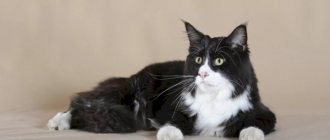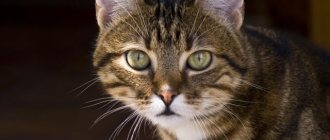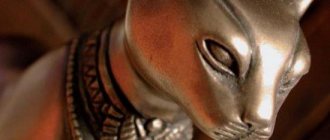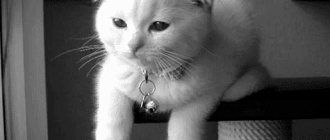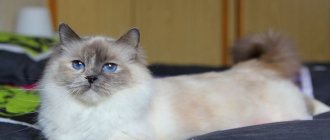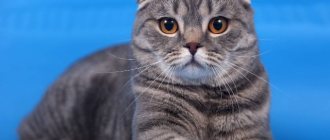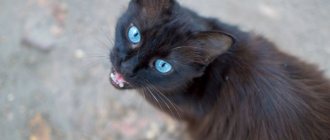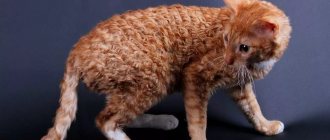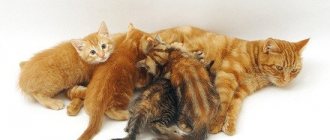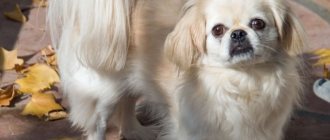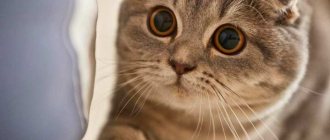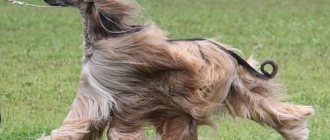April 3035448domestic cats munchkin
The Munchkin cat breed is one of the most unusual. Munchkins are short-legged cats. Because of their short legs, Munchkin cats are often called dachshunds. In this article you will find a description and photo of the Munchkin breed, learn the character of these cats, and also find information about the features of care and maintenance of Munchkin cats.
History of the breed
The origin story begins in England in 1930, when the first 4 generations of kittens were born. However, during World War II the new breed was lost.
The next mention of a Munchkin cat appeared in 1983. In the state of Louisiana, American resident Sandra found and began caring for the last representative of the munchkins at that time.
Sandra's cat, named Brambleclaw, gave a new beginning to the emergence of a species that was little known at that time. Soon the cats that had been forgotten became some of the most popular members of the family.
The species received official recognition in 1985 in the USA, where munchkins were introduced and registered as a revived breed.
In 1991, the Munchkin breed was officially announced in the Tica show.
The breed, called the Munchkin, got its name in honor of the small people of the same name from Frank Baum's book "The Land of Oz."
Color of cats
Shorthair cats: list of popular breeds
There is no official color for short-legged cats. The development of the breed occurs according to a specific program “OUTCROSS”, where crossing with any animal of the cat family is allowed. For officially registered breeds, there are a number of specific characteristics that they must meet.
Minskins have a very interesting appearance
Description of the breed
The Munchkin is a breed of cat with short legs, pronounced Munchkin cat in English. The main characteristics of the individuals are squat, with very short straight legs and a long body, which distinguishes them from ordinary cats.
Representatives of the species have a wedge-shaped head, which is directly proportional to the body. In males, the head is more developed, which shows their superiority over females.
In addition to the structure of the head, the peculiarity of cats is the heaviness of the body. Males of the Munchkin cat breed differ from females in weight by 1-2 kilograms, reaching up to 4 kg, in contrast to the opposite sex, which has up to 3.5 kg. These pets can live up to 13 years, and in rare cases, up to 20.
Long-haired representatives have shiny fur with developed undercoat, which is present most of all on the legs, neck and tail. Shorthairs have a “plush” coat.
Breeds of short-legged cats
Having achieved public recognition of short-legged cats, breeders did not stop there. They continue to experiment, creating new breeds of miniature pets.
Table: physiological characteristics characteristic of representatives of short-legged breeds
| Options | Dimensions |
| Height at withers | 15–25 cm |
| Leg length | 1/3 of the height at the withers |
| Weight |
|
Munchkin
Munchkins are the ancestors of all short-legged cat breeds. These pets are called “dachshund cats.” The similarity is due to physiological characteristics - miniature stature, elongated body and short legs.
Curious little munchkins love to control everything that happens around them. To do this, they stretch out in a column, taking a meerkat pose. Cats can stay in this position for hours, looking out the window or watching the household.
Munchkins are actively used in breeding as carriers of the gene for short legs
These big-eyed and cute “buttons,” despite their short limbs, are very active and mobile animals. They have a calm and balanced character. Cats are quite social and easily make contact with all family members and animals living in the same territory. Little ones love affection and willingly give mutual love and tenderness to their owner.
Photo gallery: Munchkin cats
Munchkin Liliput is listed in the Guinness Book of World Records as the shortest animal in the world
Munchkin kittens are very similar to a small plush toy
Curious munchkins can stand on their hind legs for hours in the meerkat pose.
Video: Munchkin cat
Minskin
The Minskin is a cross between the Munchkin and the Canadian Sphynx. Later, two more breeds were added to breeding - the Devon Rex and the Burmese. Minskins have fur on the tips of their paws and ears, which is why they are nicknamed hobbits.
Minskins are very miniature animals, weighing no more than 3 kg
Pets have a calm and friendly character. They are very sociable and easily get close to all household members and animals living in the neighborhood. Minskins are very attached to one owner and literally follow on his heels. They get very sad when they are apart, so they should not be left alone for a long time.
Photo gallery: Minskin cats
Minskin cats have a delicate skin that feels like cashmere.
Kittens have a very mischievous and spontaneous character, but with age they become more sedate
The furry points growing on the tips of the paws and ears gave munchkins their second name - hobbits.
Video: Minskin - all about the breed
Bambino
Bambino cats are a cross between a Munchkin and a Sphynx, just like the Minskin, so these breeds are often confused and the Minskin is sometimes considered a variant of the Bambino. Minskins are distinguished by the presence of hair on the head, ears, paws and tail. Representatives of the bambino breed are carriers of two special genes at once - short legs and hairlessness. The name "bambino" is translated from Italian as "child". And this is true - amazing animals remain children even in old age.
Bambinos love to sit on their hind legs, stretched out like a kangaroo.
Cute little ones have a sociable character and easily join any team. They get along well with all family members, but for themselves they choose a leader to whom they remain devoted until the end of their lives. Absolutely non-aggressive bambinos get along well with all pets living in the neighborhood. Cats make excellent companions for people who are willing to devote enough time to them.
Photo gallery: Bambino cats
The velor skin of a bambino can be of any color, but solid colors are most valued.
The ears of bambino cats are decorated with small tassels.
The graceful bambino looks like an ivory figurine
Video: Bambino cat breed
Napoleon (minuet)
The Napoleon breed was created by crossing munchkins with long-haired Persians. At first the cat was named in honor of the great commander Napoleon Bonaparte, but in 2015 the breed was given another name - Minuet. Cute babies inherited their miniature size from the Munchkins, and from the Persians - a luxurious fur coat with thick pile, large round eyes and a slightly flattened muzzle.
Napoleon owners claim that pets not only help relieve stress, but can also relieve pain
Napoleons are very gentle and affectionate pets, ready to stay with their owner all day long. Their sociability and friendliness have no boundaries. Cats are extremely attached to one owner, but treat all family members with respect. These cats absolutely do not know how to show aggression, so the breed is ideal for families with small children.
Photo gallery: Napoleon cat
Long-haired specimens of the Persian type require more frequent combing and removal of tangles. The hair of Napoleons can be long and silky, or it can be short and plush, like exotics.
The Napoleon kitten is incredibly attached to people and is in dire need of constant love and care.
Video: Napoleon cat
Dwelf
The closest relatives of Dwelfs are Canadian Sphynxes, Munchkins and American Curls. As a result of selection, offspring were obtained with short legs, a hairless body and ears bent back.
Dwelfs inherited from their relatives their miniature size, hairless body and backward-curved ears.
Despite their unusual appearance, Dwelfs are no different from their relatives. These cats are inquisitive, smart and affectionate. They choose one owner and sincerely become attached to him. Dwelfs get along well not only with all family members, but also with animals. Small pets are very vulnerable and touchy, so you need to communicate with them very carefully.
Photo gallery: Dwelf cats
Dwelf kittens have small folds on their bodies that disappear with age.
The weight of an adult Dwelf practically does not exceed 2 kg
Dwelfs have an exotic appearance
Video: Dwelf breed
Kinkaloe
The Kinkalow is a cross between the Munchkin and the American Curl. This is a young and rare breed, which numbers no more than a dozen specimens.
Kinkaloos are born with straight ears, which bend 90-180° a couple of weeks after birth.
Kinkalow wool has an extraordinary shine and silkiness.
Pets are distinguished not only by their special appearance, but also by their balanced character. Cats easily fit into any group, love social games and are quite peaceful with other animals. They choose one owner, whom they sincerely love and yearn for separation from him. Kinkalows are ideal companions that rightfully become favorites of the whole family.
Photo gallery: Kinkalow cats
Kittens' ears begin to curl two weeks after birth and are fully formed by 5 months.
Kinkalow cats can be of any color, and the color of their eyes directly depends on the color of their coat. Kinkalows inherited the signature meerkat pose from the Munchkin.
Video: miniature kinkalow cats
Skookum
The Skookum breed was created by crossing the Short-legged Munchkin and the Curly-haired La Perma. Translated from the Indian dialect, “skukum” means “brave”, “unbending”.
Pets can be short-haired or long-haired, and the longer the hair, the more curly it is.
Skookum cats inherited short limbs from Munchkins and curly hair from La Perms.
Skookums have inherited the munchkin's personality. They are incredibly inquisitive and active. Kids can spend hours playing with everything that rolls and rustles. Skookums are very friendly towards all family members, without focusing on one owner. Due to their friendly nature, pets get along well with small children and animals. Skookums are silent cats; they practically never meow.
Photo gallery: Skookum cats
Kittens are sometimes born with different colored eyes
The shorter the skookum's fur, the less curl it has.
The Skookum breed is one of the experimental ones, so purchasing kittens is quite difficult and expensive.
Video: Skookum cats
Lambkin
Lambkins (translated from English as lambs) were the result of mating a Muncchin and a Selkirk Rex. Cats look like miniature, short-legged sheep. Features of lambkins are unusual sapphire-colored eyes, strong, short limbs and curly fur. There are so few representatives of this breed that they can literally be counted on one hand.
The Lambkin breed is distinguished by short, dense limbs, curly hair and sky blue eyes.
Lambkins are very inquisitive, cheerful and restless animals. These pets love all family members without exception, but are especially attached to children. Cats are never bored and can keep themselves busy in the absence of their owners. Lambkins are loyal to all animals.
Gallery: lambkin cats
Lambkin cats look like a miniature, short-legged sheep. The Lambkin's mischievous face is decorated with curly whiskers
The little lambkin's curls resemble a perm
Video: lambkin breed
Appearance
The Munchkin and Dachshund breeds have the same genetic anomaly, which is well expressed in the structure of the body, expressed in direct proportion to the tail and body and the length of the paws.
Cats with short legs also differ:
- medium nose with a slightly noticeable deflection;
- strong neck;
- slightly visible forearms at the base of the forelimbs;
- a shaggy fluffy tail with a rounded tip - the difference between the long-haired individuals of this species;
- the eyes are shaped like a large walnut.
The eye color of these cats is rich, even in color and can easily differ from the color of the animal.
Character of short-legged cats
Castration of a cat: features of preparation for the procedure and further care
Small cats have a friendly and cheerful character. These are cheerful and intelligent creatures that will give their owner a lot of positive emotions. Despite their short legs, cats are quite mobile and easily climb up. A distinctive feature of such pets is their curiosity. Due to the structure of their body, they have to stand on their hind legs to look around.
All animals of the family are very affectionate and attached to the owner. However, they are quite silent and will never scream to attract attention to themselves. They easily get used to a new place and tolerate travel well.
Short-legged cats love to make hiding places, so you should be careful about the things around you. Otherwise, the pet will hide them in its secret place.
Munchkin fold
Representatives of this breed differ in ear set from the existing standard, but cannot be recognized as a separate species. This is due to the presence of a risk of gene mutation and, as a result, health problems.
The Fold Munchkin or, as breeders call it, Folmax, is similar in appearance to the Scottish Fold cat due to genetic abnormalities in the skeleton and ear structure.
Interesting! The long-haired, fluffy Munchkin with very short legs, despite genetic abnormalities, has become popular among experienced breeders seeking to obtain a variety of options when crossing this species with other individuals of the family.
What causes the appearance of short-legged cats?
The reason for the short legs is not due to the selection work of felinologists, but to an accidental genetic failure. Cats with short legs are born with the gene for achondroplasia (a combination of dwarfism with disproportionate development of the limbs). The important thing is that achondroplasia does not spread to the entire body, but only affects the formation of the limbs. The remaining bones and spine remain unaffected by the spontaneous genetic mutation. “Short Paws” are not prone to arthritis and have no problems with movement.
Numerous studies by felinologists have proven that genes affecting short legs do not cause any diseases.
Diseases of short-legged cats
The lifespan of short-legged cats is on average 13–16 years. The most well-known health problem in such pets is lordosis. This disease is an increased curvature of the spine, as a result of which the ridge descends and puts pressure on the internal organs. The main cause of lordosis is obesity and a sedentary lifestyle, so you need to try not to overfeed the animal and involve it in active games.
When mating short-legged cats with breeds that carry dominant genes (loose ears, lack of a tail), the babies may develop cardiopathy. In Europe, breeding animals with genetic abnormalities is prohibited.
Content Features
It should be taken into account that short-legged cats, due to their physiological capabilities, cannot jump and climb high. Therefore, before you bring a short pet into your home, you need to:
- prepare the room: remove fragile objects;
- hide dangling wires;
- remove poisonous and thorny plants.
Features of care
Short-legged cats are absolutely unpretentious in everyday life, so they do not require special care.
Dwarf cats are unpretentious in everyday life, so they do not require special care
Basic rules should be followed:
- comb the animal once a week (during the molting period - every day);
- bathe the cat once every 4–6 months (or when dirty);
- treat your eyes with a cotton swab every day;
- clean your ears with cotton swabs every 7–10 days;
- cut nails once every 14 days;
- treat the oral cavity with special preparations at least once a week;
- timely introduce a vitamin-mineral complex into the diet.
Breeding Features
Short-legged cats are divided into two types:
- standard - animals with short legs;
- non-standard - long-legged pets.
Non-standard animals inherit all breed qualities and actively participate in the inbreeding program. To improve the gene pool, mating of standard and non-standard individuals is allowed.
One litter can produce cats with both short and long legs.
Two long-legged parents will never produce short-legged kittens.
Character traits
The short-legged Munchkin cat has a friendly disposition and always finds a common language with other pets: the cat’s dogs will not see her as a rival.
The pet respects its owners and easily adapts to the mood. Strangers also quickly establish contact with the kitten after seeing its feline charm and kindness.
Walking around the room, they stomp their feet like hedgehogs, which also lifts the mood. The cheerful, playful, easy-going nature of the munchkin will not leave anyone indifferent.
These cats are curious and friendly, love to play and easily tolerate the “squeezing” of children, do not show aggression towards other pets, but can catch smaller animals: birds and rodents.
The presented description of the breed shows that understated Munchkin cats can easily make friends not only with an adult owner, but also with a child.
Munchkin cat character
The munchkin cat has a wonderful character. They are very peaceful, intelligent, affectionate and sociable. The friendly and patient nature of the Munchkin cat makes them one of the best cat pets. The Munchkin cat breed is very inquisitive; these cats get along well even with children. The nature of the Munchkin cat is very calm, but if necessary, they can quite stand up for themselves.
Munchkins' short legs do not prevent them from running and jumping quickly. These are very funny, nimble and curious creatures. Munchkin cats are energetic, agile and fast. Munchkins run quite fast and stomp their short legs very funny. Munchkins cannot jump high, but they are very active, so they will always find an alternative option to climb higher.
Munchkin cats are amazing creatures that are full of warmth and tenderness towards people. Munchkins adapt very easily and quickly to the regime of their owners. These cats love to take part in family gatherings, household conversations and always sense a person’s mood. Munchkins treat guests with friendliness and interest. The munchkin cat's docile nature allows it to get along well with other animals in the house. These cats can walk on a leash and love to travel.
There is one small flaw in the munchkin cat's character. They love to take possession of various small things. If a munchkin lives in your house and some little thing is missing, look for it in your pet’s favorite secret corners. As for Munchkin kittens, you often have to look for them yourself. Kids are very curious and often find themselves in difficult situations, climbing into hard-to-reach places. This is especially true for various hills, which, having climbed, they cannot get down themselves.
Nutrition
The short-legged Munchkin needs only a healthy and proper diet. It is advisable to include in his diet:
- meat - most of the diet should be from this product;
- vegetables, fish, eggs and cereals should be given 1-2 times a week.
All products must be selected carefully and ensure that the prepared food is low-fat. Due to the fact that your pet loves to eat, it is necessary to follow a feeding schedule, taking into account how active it is and in what physical shape. If the cat is fat, you need to slow down the pace of feeding and ask a specialist for advice on proper care of the animal.
Care and hygiene
Munchkin cats are extremely clean and quickly learn to use the litter box. It is advisable for them to choose a toilet with high sides or a closed one. Caring for and maintaining a short cat is not particularly difficult. It is enough to wipe your ears with it a couple of times a month and regularly wipe your eyes. If you wish, you can trim your claws, but these pets rarely damage furniture; a scratching post is enough for them.
Short-haired cats need brushing once a week, and a little more often during shedding. Long-haired dogs will need to be brushed a couple of times a week and daily if they shed. It is worth noting that hairs are easily removed with a furminator.
For the safety of your pet, it is advisable to remove all potentially dangerous objects higher up.
What to feed a munchkin
The Munchkin cat is a big fan of food, so it often suffers from excess weight. The owner should monitor the calorie content and portion size. It is also important to remember that the breed needs predominantly protein foods. If an industrial type of food has been chosen, then preference should be given to specialized premium and super-premium food.
Natural nutrition should consist of lean meat, for example, veal, chicken, turkey. You can give rabbit meat, sometimes sea fish and eggs. All food should be given to the cat ready-made without salt. You can add a small amount of vegetables and cereals to your diet.
A kitten should eat at least 6 times a day; an adult cat needs 3 meals.
Health
Representatives of this breed are in good health, but despite their excellent physical condition, they are plagued by back problems: lordosis, a disease expressed in the deflection of the spine due to weak muscles.
In addition to changing the position of the spine, this disease affects the heart and lungs - death is possible. To keep your cat healthy, you need to take it to the veterinarian and get the necessary vaccinations to prevent diseases.
It is possible to crossbreed only long-haired and short-haired representatives of the species in order to exclude deaths during the birth of kittens, as well as the transmission of life-threatening diseases.
Features of choosing kittens
Cats with short legs have gained popularity and become desirable for many people. However, you also need to purchase them carefully.
How to choose a nursery to buy or buy secondhand
It is better to purchase a real kitten from a specialized nursery, and not from someone else. Unfortunately, there are quite a few such establishments in Russia, so it is better to look for an animal in other countries. You need to make sure that the institution and the future pet have all the documents.
Buying it secondhand is fraught with the risk of receiving a sick baby who is passed off as healthy, but elite and purebred.
How much do these breeds most often cost?
The cost of short-legged kittens varies from 5 thousand rubles*. Only animals with any deviations from breed standards are sold cheaper. Approximate prices for kittens:
- Napoleon - from 30 to 80 thousand rubles;
- munchkin - from 5 to 30 thousand rubles;
- kinkalow – from 500 to 1000 euros;
- Skukum – from 800 to 3500 euros.
What parameters of a kitten to pay attention to when choosing
When purchasing, you should pay attention to the baby’s condition, his activity, and absence of diseases. It is recommended to ask the owners for documents and all certificates. A cat child should be cheerful, playful, eat well, have clean eyes, nose, and skin.
Short-legged cats are cute and friendly. This beautiful and kind animal will bring a lot of joy to its owner, and its unusual appearance will not affect its health and development in any way.
*Prices are current as of September 2022.
Kitten in the house
In order for a munchkin kitten to appear in a family, you need to think about where you can buy a pet. When choosing a place of purchase, you should pay attention to nurseries and what breeders of this breed will offer, since Munchkin kittens in such places of sale will already be litter box trained and with the necessary vaccinations.
If you are not satisfied with the prices of breeders or kennels, you can use other places, such as exhibitions or online advertisements, but remember that there is a risk of buying a false munchkin.
A munchkin costs from 3 to 20 thousand rubles. The cost mainly depends on the color and age of the individual.
Summarizing all of the above, we point out that when the choice of pets is made, it must be conscious and made with maximum responsibility.
How much does a munchkin cost?
Short-legged Munchkin cats, despite their popularity, are quite rare. In Russia, purchasing a baby can be difficult, especially considering that ordinary “nobles” kittens are often sold under the guise of inexpensive “dachshund cats.”
In trusted nurseries, the cost of a pet-class baby starts from 15 thousand rubles. A show-class cat will cost at least 60 thousand rubles.
Choosing a kitten
Pets of the short-legged breed should only be purchased from trusted breeders. In a good nursery, children will receive age-appropriate vaccinations and be treated for parasites. A munchkin kitten must have documents even if it is classified as a pet.
When purchasing a munchkin cat, you should inspect it visually and observe its behavior. The kitten should not have any damage or bald spots on its skin. His fur should be well-groomed. You should also look into the ears and make sure there are no ear mites. A healthy baby is mobile, active and easily makes contact with people.
The Munchkin is an ideal pet for any person who can give him enough attention. A good-natured disposition and tenderness will relieve loneliness, give you a partner for games or a fur vest for tears.
Description of munchkins
The description of the munchkin always begins with the limbs; at first glance, their paws are the same size. Although it often happens that the front legs are shorter than the hind legs.
The forelimbs consist of segments that are the same size. The paws of munchkins are 2 times smaller in length than the usual size, and sometimes even 3 times.
The Munchkin breed has distinctive features/Yandex Collections
Standard animals have an elongated body, somewhat wide. The chest is round, the back is inclined upward towards the tail, the hips are strong. The shoulder blades may be angular. The body of the animal is small but muscular.
The Munchkin's head is similar to a wedge, but with rounded sides. In an adult, the head is proportional to the body. The munchkin cat has high cheekbones.
The flat forehead seems to blend smoothly into the nose. No other characteristics of the muzzle are observed. The neck of cats is muscular, strong, dense, large, and smaller in cats.
The ears near the head are wide, set high and wide. The ears are rounded at the tips. They come in large and medium sizes. Animals with semi-long hair have tassels on their ears. Munchkin Scottish kilts can be with erect or recumbent ears.
Almond-shaped beautiful eyes can also be large or medium. The eyes are located at an angle relative to the ears. They are set wide apart, making the face sweet and open.
The color of an animal's eyes does not depend on its color; green, yellow, and blue are found. The coat can be of different colors as the breeds are crossed. There are bright red, bicolor, tricolor, noble gray, golden, spotted, and tabby cats.
The rarest and most valuable specimens are marbled and chocolate in color. There are cats that have no hair at all after crossing with sphinxes.
The tail is of medium thickness and is proportional to the body. When the cat moves, the tail is always in a vertical position. Animal fur can be long, semi-long, or short.
The feel may vary depending on the variety. There are only positive reviews about the munchkin breed, partly because the cats are hypoallergenic and do not cause allergic reactions in people.
